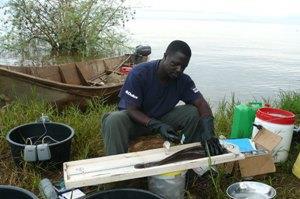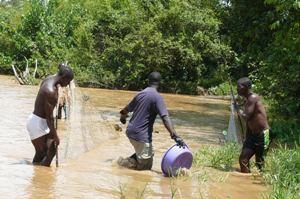Mbalassa Mulongaibalu
The project aims to quantify the migratory patterns of fish species, identify vital spawning and breeding areas, and define migration extent and timing along the river and tributaries as appropriate.

Mbalassa tagging Clarias specimens.
The fishery activities in Lake Edward and its affluents are among the major economic activities sustaining livelihoods for the large majority of local riverine communities. In spite their importance, the conservation and management of the aquatic critical habitats is still thus far neglected. In turn, the fisheries productivity is declining at alarming rate. This is partly due to the degradation of critical aquatic habitats important to support fish reproduction and repopulation. Furthermore, the growing populations, rapid industrialization and the oil exploitation in the region are predicted to exacerbate the pressure on freshwater ecosystems. This requires that appropriate action should be taken for sustainable management of the fishery resources. However, an incomplete understanding of freshwater fisheries ecology, at the managerial level, often hampers proper planning and management.

Mbalassa (middle holding basin) during fishing process with locals along Ishasha River.
This project focuses on freshwater resources in Virunga (ViNP) and Queen Elizabeth National Parks (QENP) in the Albertine Rift region, East Africa. The project is part of an initiative that aims to provide fundamental knowledge necessary to support sustainable management and conservation of fishery resources in ViNP and QENP.
The study intends to investigate fish migration movements along Ishasha River and Lake Edward. It seeks to quantify the migratory patterns of fish species and identify their vital spawning and breeding areas, as well as to define migration extent along the river and tributaries as appropriate. It will also determine migratory periods of fish species and their life stages. It will further take into account the environmental factors (droughts and floods) and measure limnological parameters of waters in the river and lake critical habitats.
The understanding of the migration patterns of the fish as well as the timing of fish movements could help to inform recommendations for collaboration with locals in managing fishery resources. This could also help identify threats to aquatic fauna that may need to be regulated around the aquatic ecosystems. When the understanding of fish migration patterns and identification of threats to aquatic fauna happen, it would be easy to develop adaptive strategies for people who depend on the river and lake for their livelihoods. Accordingly, the results from this research will have important conservation and management implications. This is so because detailed knowledge about fish migration patterns is required to assist in planning and implementing effective conservation and management programs for fisheries in both Lake Edward and Ishasha River in particular and all the Albertine region aquatic ecosystems in general.